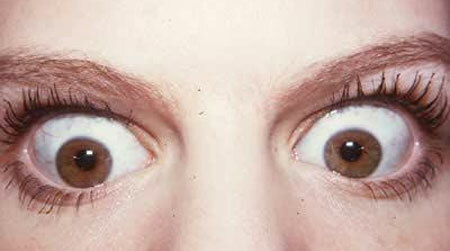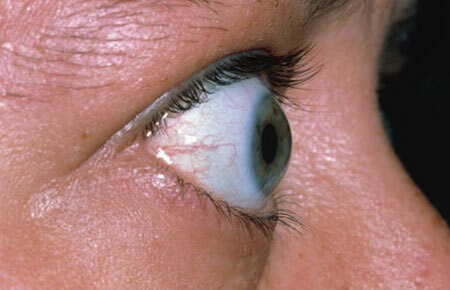Diseases of the thyroid gland are amenable to therapy in different ways depending on the severity of the patient's condition: this is a medical method, and folk medicine, and even surgical intervention. In any case, a diet that supports the body against a background of hormonal imbalance caused by thyroid disease is required.
Content
- 1 Thyroid
- 2 principles of diet in various diseases of thyroid
- 2.1 Video: healthy food to improve cancer
- 2.2 Endemic goiter
- 2.3 Inflammation( thyroiditis) and neoplasms
- 2.4 Hypothyroidism
- 2.5 Hyperthyroidism( thyrotoxicosis)
- 2.6 Duration of the diet
- 2.7 Diet specialties for thyroid pathology in women
- 2.7.1 Diet during pregnancy for thyroid pathology
- 2.8 Diet for thyroid pathologyin children
- 2.8.1 Video: Pediatrician Komarovsky about the benefits of iodine for children and pregnant women
- 2.9 Features of the diet for thyroid pathology in men
- 3 Authorized and prohibited products for thyroid diseases
- 3.1 Table: Important products for diseases of the thyroid
- 3.1.1 Video: harmful products for thyroid
- 3.2 List of products recommended for hypothyroidism
- 3.2.1 Table: Top products with maximum iodine content
- 3.2.2 Photogallery: productiodine-containing
- 3.3 List of products recommended for hyperthyroidism
- 3.3.1 Photogallery: zobogenous products
- 3.3.2 Video: hypothyroidism: permitted and non-recommended products
- 3.1 Table: Important products for diseases of the thyroid
- 4 Menu for thyroid diseases
- 4.1 Table: menu for 5 dayswith hypo- and hyperthyroidism
- 4.2 Recipes for hypothyroidism
- 4.2.1 Salad from sea kale
- 4.2.2 Apples baked with figs
- 4.3 Recipes for hyperthyroidism
- 4.3.1 Rice with tofu( soy cheese)
- 4.3.2 Salad from fresh cabbage and raisins
- 5 Result of the diet
Thyroid gland diseases
The thyroid gland is the main and largest organ of the endocrine system, located in the anterior part of the neck, above the sternum, covering the trachea and larynx. The gland is an unpaired organ, its structure is represented by two different parts, which are connected by a small isthmus.
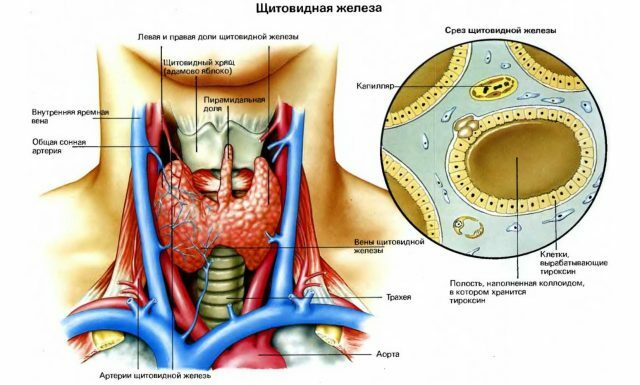
The gland has the shape of a horseshoe with a concavity facing back
The leading function of the thyroid gland is the production of biologically active substances for the regulation of processes occurring inside a person. These substances include hormones:
- thyroxine( T4),
- triiodothyronine( T3).
These organic compounds control the exchange of proteins, fats and carbohydrates( Bzhu), protein synthesis, tissue development, cardiac and vascular function, gastrointestinal tract, responsible for mental state and sexual development. The decrease or increase of thyroid hormones leads to violations of the above-mentioned functions under their control.
The amount of T4 and T3 is regulated by the thyroid-stimulating hormone of the pituitary( TTG) according to the principle of inverse interaction: the higher the TSH, the lower the intensity of the gland and vice versa. The level of TTG is indicative in the diagnosis of the thyroid gland: if its number is in order, then the thyroid function without disturbances.
Diseases of the gland can be differentiated by the nature of the onset:
- diseases caused by a malfunction in the thyroid gland and, as a consequence, a change in the hormonal background:
- hyperthyroidism is an increase in the production of gland producing hormones T3, T4.As a consequence, there is a decrease in TSH.This can be caused by Graves' disease or thyroid autonomy. Symptoms are:
- hand and whole body tremor,
- increased irritability,
- weight loss despite high appetite,
- hypertension,
- tachycardia,
- atrial fibrillation,
- sleep disorder,
- sensation of fever,
- digestive disorders in the form of diarrhea,
- sometimes- defeat of the eyes, eyelash.

Diffuse toxic goiter is most often found in women aged 20 to 50 years.
- hypothyroidism is a decrease in thyroid function caused by autoimmune thyroiditis( thyroid inflammation).Symptoms:
- impotence,
- lethargy,
- feeling of freezing,
- obesity,
- puffiness,
- weak pulse,
- elevated cholesterol,
- pallor of the skin,
- impaired gastrointestinal tract as constipation,
- impotence.

Unexplained weight gain may be a symptom of hypothyroidism
- hyperthyroidism is an increase in the production of gland producing hormones T3, T4.As a consequence, there is a decrease in TSH.This can be caused by Graves' disease or thyroid autonomy. Symptoms are:
- diseases that develop due to a change in thyroid structure:
- thyroid growth in size( diffuse goiter),
- endemic goiter - an increase in thyroid size as a consequence of a deficiency in iodine,
- emergence of nodal formations iniron( nodular goiter):
- malignant nodes,
- benign nodes,
- hyperthyroid-provoking nodes,
- nodes that do not produce hormones.
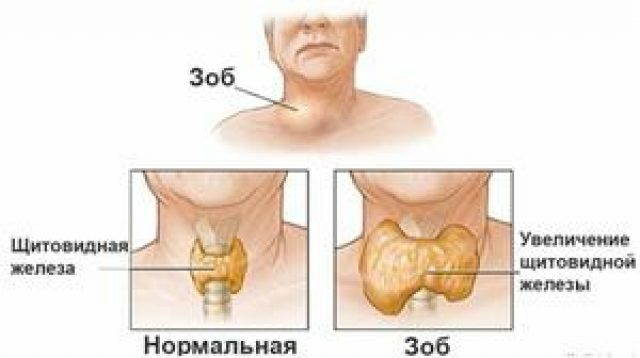
Problems with the functioning of the thyroid cause tissue degeneration and the formation of
- nodes in the formation of cysts in the gland.
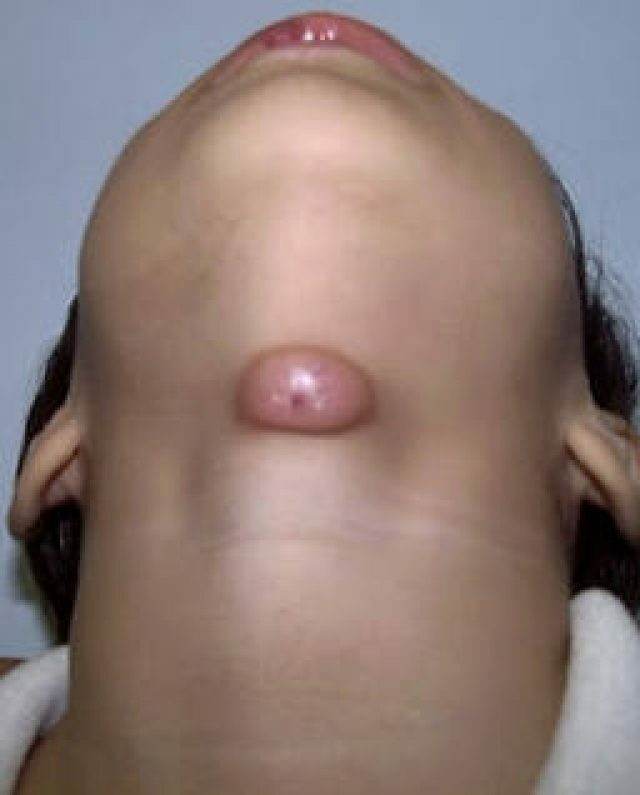
Thyroid cyst is a benign nodal cavity filled with colloidal fluid
For hypothyroidism, iodine is necessary for the normal functioning of the gland and the production of a sufficient amount of hormones. Iodine enters the body from the outside with the use of iodine-containing products. Due to the insufficiency of this microelement, iron begins to grow, trying to compensate for the small production of hormones, which can result in endemic( iodine deficiency) goiter.
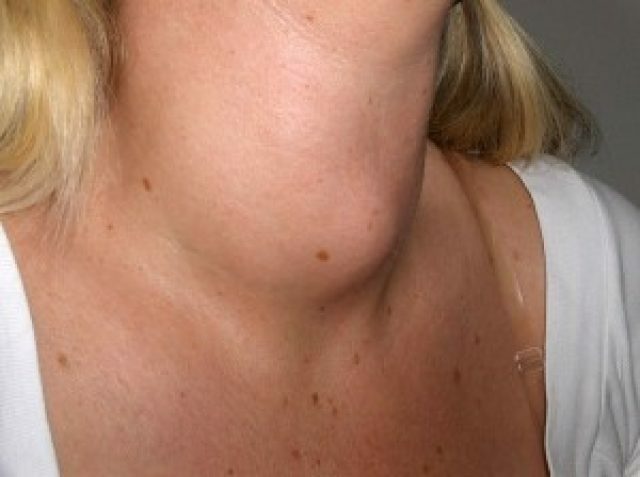
Endemic goiter - enlargement of the thyroid gland, changing the shape of the neck, which develops due to lack of iodine in people living in areas with iodine deficiency in the environment
Compliance with a diet with sufficient iodine content - 150 μg daily - will ensure the prevention of hyperplasia of thyroid gland and the appearance of nodalformations. Especially important is the diet during pregnancy and lactation to prevent the development of endemic goiter.
Most - over 90% of the daily requirement for iodine comes into the body due to the human diet.
The goal of a diet in which iodine-containing foods predominate is to reduce the risk of iodine deficiency thyroid disease or, if this condition has already developed, the cure for this disease. The purpose of the diet for any thyroid pathology in general is the return of the previous hormone balance for the normalization of the functioning of the body systems.
Principles of a diet for various diseases of the thyroid
Adherence to the correct diet in the treatment of the endocrine system does not at all mean the widespread addition of iodized salt to food. Depending on the medical conclusion, a diet is selected to obtain the maximum therapeutic effect, while some states assume complete elimination of iodine intake.
General principles of the diet for all diseases of the thyroid are:
- fractional meals five or more times a day for proportional production of hormones;
- food intake at the same time;
- increased protein content in the diet;
- use of multivitamin complexes;
- use for drinking and cooking only filtered pure water with a minimum content of fluoride, detrimental to thyroid function;
- refusal of alcohol.
Video: useful food to improve gland function
Endemic goiter
Because the cause of endemic goiter is iodine deficiency, the diet is based on the inclusion of iodine-containing foods in the diet and the simultaneous exclusion of plants and products that provoke or aggravate the enlargement of the thyroid gland.
According to WHO, about 2 billion inhabitants of the Earth exist in conditions of iodine deficiency.
Ph. D.Yulia Volkova, Endocrinologist
Science and Life Magazine №1, 2015
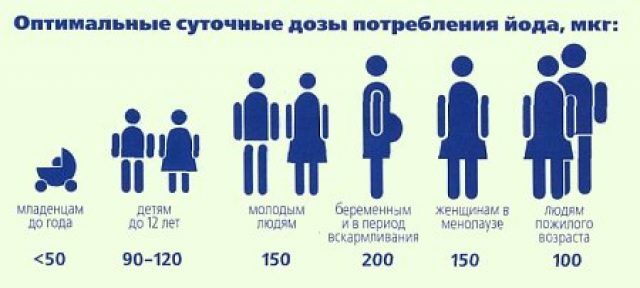
iodine deficiency is especially common in areas far from the sea
People living near the sea are less likely to have iodine deficiency diseases because of their ubiquity: in air, soil and food. Seafood is the main natural source of iodine, therefore patients with diagnosed iodine deficiency always receive a recommendation to include in the diet marine fish, seaweed and seafood.
In addition, for the assimilation of iodine, the presence of selenium in the body is necessary, therefore along with the iodine-containing diet it is necessary to consume products containing selenium:
- the same seafood;
- products from wholemeal flour;
- cereal products;
- chicken eggs,
- mushrooms;
- vegetables, especially onions and garlic.
In Russia, the requirement for selenium is set at 55 μg / day for women, 75 μg / day for men, 10-50 μg / day for children.
Research Institute of Nutrition of the Russian Academy of Medical Sciences
Methodical recommendations 2.3.1.2432-08.Norms of physiological needs in energy and nutrients for various groups of the population of the Russian Federation.
Inflammation( thyroiditis) and neoplasms
When thyroiditis and the appearance of tumors( including malignancies) in the gland, cysts, knots should avoid the use of foods with high iodine content, as well as those plants, vegetables and other products that contribute to the growth of goiter.
Hypothyroidism
Insufficient production of thyroid hormones provokes the development of edemas and increases cholesterol, slows metabolism. In order not to aggravate these manifestations of hypothyroidism, you must adhere to the following principles in the diet:
- decrease in salt intake;
- consumption of foods high in tyrosine( fish, meat, dairy products, nuts, bananas, legumes);
- preference for eating foods with lower calorie content( in general, the nutritional value of the ration of a patient with insufficient thyroid activity should be reduced by about a quarter compared to a healthy person, which is about 1800 kcal):
- decrease in fat intake;
- preference for complex carbohydrates instead of fast ones;
- increased protein intake.
- restriction of food intake of animal products;
- to avoid eating high in vitamin A and carotene( limit, but not eliminate).The thing is that the assimilation of this substance is impossible with inadequate functioning of the thyroid gland, will lead to accumulation of vitamin A in the body and yellowing of the skin;
- inclusion in the diet of iodine-containing products;
- liquid limitation up to 1.5 liters.in a day;
- to prevent constipation eating fresh lactic acid foods and fiber.

When filling the shortage in the body of iodine, it is strictly forbidden to consume alcohol solution of iodine from the pharmacy, even in the number of drops
Hyperthyroidism( thyrotoxicosis)
Excessive thyroid hormone production provokes the acceleration of metabolism and, as a result, the expenditure of large amounts of energy, proteins and fats. This explains the following recommendations for a diet for hyperthyroid patients:
- an increase in the daily caloric intake of the diet to 3,000 kcal;
- use of products containing zobogenous substances: isoflavone and isothiocyanate( crucifers, soy products, spinach, rutabaga, daikon, etc.);
- restriction of iodine-containing products and iodized salt;
- preference for dairy products with a high content of calcium( fatty cottage cheese, cheese, milk);
- exclusion of products that exert a stimulating effect on the nervous system: chocolate, alcohol, spices and herbs, limit tea and coffee;
- for diarrhea - rejection of laxative products, as well as causing fermentation processes in the intestine( fresh baking, grapes, fatty fish, etc.).
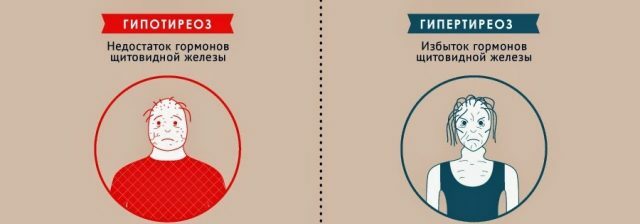
The goals of the diet for hyperthyroidism are to improve the nutritional status of the body, normalize its nutritional status, enhance the body's defenses, strengthenregenerative processes
Duration of the diet
The duration of the diet depends on the severity of the thyroid pathology, as well as on the individual characteristics of the patient. In general, the restoration of proper operation of the thyroid gland is a long-term process, and therefore it will be necessary to adhere to the diet very long. In order to obtain the first results, the prescribed diet should be observed for the first two months of treatment, while a gradual but daily cancellation of the contraindicated products takes place to mitigate the adaptation period. With a full transition to the appropriate diet, you need to stick to the nutrition plan for at least six months, preferably eight months. After this time, we can already talk about the results obtained in the form of normalizing the hormonal balance.
To maximize the effect of therapy should adhere to the diet for a period of one year. After that, it will be possible to slightly reduce the diet, observing only the basic principles.
Features of the diet in thyroid pathology in women
Normal functioning of the thyroid gland is necessary for women not only for a full life, but also for the possibility of conception.
Basic principles:
- daily need for iodine should be 150 mcg. Imbalance of hormones significantly affects the appearance, completeness, dryness of the skin, hair density and fertility, so adherence to diet is so important for the fair sex;
- the amount of protein consumed should be not changing 1.2 g per kg of weight;
- in hypothyroidism is particularly important to count calories, because the female body is more inclined to accumulate mass than the male. Recommended vegetarian diet and raw diet;
- in hyperthyroidism is given particular attention to drinking regimen( for women after 45 years the norm is at least 2 liters of pure water) and daily use of zobogenic products.
Diet during pregnancy for thyroid pathology
During pregnancy, as well as during lactation, in order to avoid malformations of the baby and the growth of endemic goiter, the mother recommends an increase in daily intake of iodine to 200-250 mcg. Depending on the diagnosis, it is necessary to adhere to the above-mentioned principles of the diet for each individual pathology. The difference is only in the increased dose of iodine consumed per day. Pregnant women, as well as patients with hypothyroidism in general, can fill the deficit with iodized salt if there is no propensity to edema. For the best result it is necessary to adhere to the following rules:
- to buy only that salt, from the moment of extraction which has not passed more than half a year. Otherwise, the content of iodine in it will be insufficient;
- salt must be stored in a tightly closed jar;
- fill the food with salt only after bringing it to the ready, because during the heat treatment salt loses a significant amount of iodine.

One gram of this product contains almost half the daily intake of iodine
. In hyperthyroidism, pregnant women should pay special attention to consuming enough calcium to provide their own body and the formation of the fetal skeleton. It is also recommended to bring the daily calorie content to 3200 kcal due to rapid metabolic processes.
Diet in the pathology of the thyroid gland in children
The norm of iodine intake in children under two years is 90 mcg, after 24 months the norm rises to 120 mcg.

Normal functioning of the thyroid gland is directly related to the development and achievement of children
The main points that should be taken into account in thyroid pathologies in children:
- in hyperthyroidism:
- it is important to observe the intake of calcium-containing products, because this microelement is especially important for a growing organism,building bones and teeth;
- for the same reasons paid attention to protein products( the norm for patients with thyrotoxicosis of children - 2.0 grams of protein per kilogram of weight);
- total caloric intake should be increased by 20-25%.
- in hypothyroidism:
- use iodized salt as a seasoning;
- if the infant is thoracic, use a mixture with sufficient iodine, with natural feeding, the mother must observe sufficient intake of iodine;
- control of caloric intake, exclusion of foods with high cholesterol: egg yolks, butter, fatty pork.
- iodine deficiency goiter:
- diet therapy in children is relative, it is mandatory to use iodine and iodinated products. In iodine deficient regions, prevention of a deficiency of this microelement is obligatory: in educational establishments it is necessary to feed iodized bread, tea, and other products to the children's table.
Video: Pediatrician Komarovsky about the benefits of iodine for children and pregnant women
Features of the diet for thyroid pathology in men
Despite the fact that thyroid disorders are more typical for women, men are also at risk of endocrine pathology. Both hypo and hyperthyroidism negatively affect health and male fertility.
Power Features for Men:
- daily requirement for iodine - 150 mcg;
- thyrotoxicosis occurs in men is harder, it is necessary to simultaneously comply with the diet for the prevention of osteoporosis;
- daily intake of protein - not less than 1.5 g per kg of body weight.
Prohibited and Prohibited Products for Thyroid Diseases
For pathological thyroid diseases, there is a general list of products that are recommended for use with both thyroid hypothyroidism and hyperthyroidism.
Table: Important products for thyroid diseases
| Recommended products | Foods banned |
|
|
Video: harmful products for thyroid
Also, depending on the type of pathology of the thyroid gland, it is necessary to give preference to certain types of products that help fight the disease.
List of products recommended for hypothyroidism

Vegetarian diet is recommended for hypothyroidism because of the high content of organic iodine in fresh vegetables and low calorie content.
The basis for the treatment of hypothyroidism with dieteteapia is the inclusion of iodine-containing foods in the daily diet of the patient.
Table: Top products with maximum iodine content
| place in the ranking | Product Name | iodine content, mg per 100 g of fish oil |
| 1 | 700 | |
| 2 | cod liver | 370 |
| 3 | seaweed | 300 |
| 4 | haddock | 245 |
| 5 | salmon | 200 |
| 6 | shrimp | 190 |
| 7 | hake | 150 |
| 8 | salted herring | 77 |
| 9 | apples | 70 |
| 10 | oysters | 60 |
| 11 | salmon | 50 |
| 12 | persimmon | 49,7 |
| 13 | oats | 20 |
| 14 | spinach | 20 |
| 15 | eggs | 18 |
As follows from the table, the best sources of iodine of natural origin are seafood and sea fish, from fruits - apples( together with seeds) and persimmon, from vegetables - spinach, from cereals - oats. Do not forget that in the process of cooking iodine is lost and eating foods is fresh, and you should also season the food with iodized salt after preparation( it is necessary to observe the dosage of salt and not try to replace it with all the necessary iodine, because salt provokes fluid stagnation).
Photo Gallery: high iodine products
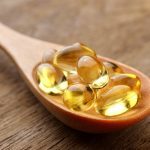 Fish oil is the leader in the content of iodine and healthy fatty acids
Fish oil is the leader in the content of iodine and healthy fatty acids 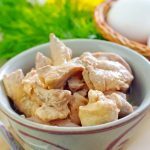 Cod liver is a natural source of iodine
Cod liver is a natural source of iodine 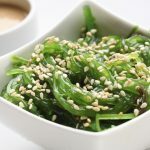 In seaweed, iodine content can reach up to 0,2%
In seaweed, iodine content can reach up to 0,2% 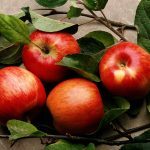 It is known that iodine in apples is much larger, Oats - the cereal with the highest iodine content, which should be consumed in raw form, for example, muesli bars
It is known that iodine in apples is much larger, Oats - the cereal with the highest iodine content, which should be consumed in raw form, for example, muesli bars  The products most rich in iodine are all kinds of seafood: mussels, oysters, squids, crSea fish,
The products most rich in iodine are all kinds of seafood: mussels, oysters, squids, crSea fish, In addition to the above, increases the production of hormones shchitovidki ginger. The root of ginger is also known as a means to stimulate weight loss, prevent the development of intestinal infections and impotence in men.
For sweet dishes, it's best to avoid them or replace them with diet puddings, jelly, jelly. Instead of sugar, honey and bee products should be preferred. Also, you should pay attention to coffee - you need to separate the intake of hormonal drugs and the use of this drink, because it binds the necessary hormones for treatment, making them not digestible.
In addition to eating, it is necessary to pay due attention to the fluid used - the tap water contains fluoride, which reduces the amount of iodine in the body, so an alkaline mineral water is recommended as a drink.
List of products recommended for hyperthyroidism
In thyrotoxicosis, special attention is paid to zobogenous products that suppress thyroid hyperfunction and prevent excessive production of hormones.
The main products that have such an effect are crucifers( cabbage colored, white-head, broccoli), vegetables with high fiber content, as well as soy and soy-containing products. It is desirable to eat vegetables in raw form, since after heat treatment products are already deprived of this property due to the destruction of zobogenic enzymes. That is why raw diet is so useful in hyperthyroidism. Separately it is worth noting soy and millet - even after cooking these products do not lose their creeping properties.
| Day n / a | Diet for hypothyroidism | Diet for hyperthyroidism |
| day first | breakfast: scrambled eggs, red caviar sandwich, chamomile tea | breakfast: millet cereal, bread yesterday with butter, coffee |
| 2nd breakfast: kisseloatmeal with berries, oatmeal toast | 2 breakfast: yogurt 5%, crackers | |
| lunch: vegetable soup, turkey steak fillet, green tea leaf | lunch: fresh cabbage salad, borsch with sour cream, yesterday bread, cocoa | |
| afternoon snack: apple bakedwith raisins and honey, glass is rankedand | afternoon snack: fruit salad, curd 9% | |
| dinner: seafood, baked with potatoes without oil, cocoa | dinner: chicken cutlet with potatoes, spinach salad with greens, black tea | |
| day two | breakfast: porridge buckwheat on low-fat milk, coffee drink | breakfast: soy cheese, toast, omelette, coffee with milk |
| 2nd breakfast: apple, ginger tea | 2nd breakfast: pancakes with honey, green tea | |
| lunch: risotto with seafood, cucumber salad and greens, tea with melissa | lunch: pasta with beef liver, lettucecucumber, daikon and greens, tea | |
| snack: low fat yoghurt, persimmon | snack: oatmeal cookies with candied fruit, coffee | |
| dinner: pumpkin porridge, beet salad with cheese, chicory drink | dinner: meat zrazy with egg, cabbagestewed, freshly salted salad, freshly salted salad, | |
| juice third day | breakfast: oatmeal with milk, raisin compote | breakfast: sour cream with sour cream, coffee with milk, banana |
| 2nd breakfast: figs, natural yoghurt | 2nd breakfast: milk soup with vermicelli, fruit tea | |
| lunch: mushroom soup puree, baked chicken fillet, cabbage salad | lunch: soup with beef, broccoli salad with flaxseed oil, cocoa | |
| snack: herbal tea, prunes | snack: vegetable freshly squeezed juice, cheese, toasted oats on fructose | |
| dinner: salad fromseafood, water with lemon without gas | dinner: stewed beans, beef cutlet, yesterday's bread, tea | |
| day the fourth | breakfast: vegetable ragout, berry smoothies, peppermint tea | breakfast: oatmeal porridge with linseed oil, yesterday's bread, cheese, tea |
| 2nd breakfast: cottage cheese 3%, applejelly | 2nd breakfast: cottage cheese mass with candied fruit, coffee with milk | |
| lunch: haddock steamed, potato puree, compote | lunch: wheat porridge with soy meat, vegetable soup with breadcrumbs, tea | |
| snack: milky jelly, alkaline miner | snack: fruit salad with cream, egg cocktail | |
| dinner: veal stew with veal, a glass of fresh yogurt | dinner: roast of mushrooms and soy meat, spinach salad, jelly | |
| day five | breakfast: curd cheese cakes 3%, cocoa | breakfast: hard boiled egg, pastry, coffeeon cream |
| 2nd breakfast: apple chips, chicory drink | 2nd breakfast: yoghurt 5%, banana, soy milk | |
| lunch: sea fish soup, vinaigrette, mineral water | lunch: cream soup from vegetables, beef stew with greens,tea black | |
| afternoon snack: seaweed salad, one hard-boiled egg, tea with ginger | afternoon snack: curd-rice pudding, dried fruits, green tea | |
| dinner: buckwheat with cod liver, fruit tea | dinner: cauliflower salad with vegetable oil,chicken fillet, morsel |
Coffee affects the production of thyroid hormones, suppressing their activity. With hyperthyroidism, no more than three cups of coffee can be consumed per day, so as not to cause overexcitement of the nervous system.
Broths and infusions of bitterness in hypothyroidism are used to stimulate appetite and set the appropriate caloric value for the whole day. This can be decoctions of wormwood, dandelion, ayr, centaury, yarrow, etc.
Photo Gallery: zobogenous products
 Plants from the family of cruciferous plants, which include cabbage, Brussels sprouts, cauliflower, broccoli, turnip, rape, horseradish and cress contain thiocyanatesand isothiocyanates - zobogenous substances
Plants from the family of cruciferous plants, which include cabbage, Brussels sprouts, cauliflower, broccoli, turnip, rape, horseradish and cress contain thiocyanatesand isothiocyanates - zobogenous substances 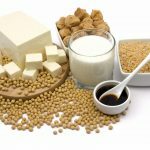 Soybeans and products based on it are related to goitrogens( substances that cause the growth of goiter)
Soybeans and products based on it are related to goitrogens( substances that cause the growth of goiter) 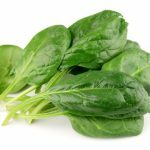 Green foods include spinach, mustard greens, lettuce, bamboo shoots
Green foods include spinach, mustard greens, lettuce, bamboo shoots  Coffee suppressantst excessive generation of hormones
Coffee suppressantst excessive generation of hormones 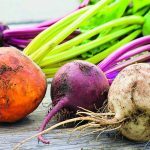 Root crops and vegetables in their raw form should constitute the main part of the diet for hyperthyroidism
Root crops and vegetables in their raw form should constitute the main part of the diet for hyperthyroidism 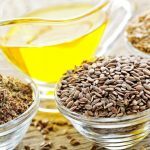 Flaxseed oil and flax seeds, in addition to preventing excessive production of thyroid hormones, have cleansing properties
Flaxseed oil and flax seeds, in addition to preventing excessive production of thyroid hormones, have cleansing properties Video: hypothyroidism: allowed and non-recommended products
Menu for diseases of thyroid
Depending on the pathology, the menu for weight reduction is distinguished( for hypothyroidism, diet No. 8) and for its maintenance( for hyperthyroidism).
Table: Menu for 5 days with hypothyroidism and hyperthyroidism
Recipes for hypothyroidism
The salads below are recommended for hypothyroidism due to low caloric content and high iodine content.
Salad from sea kale
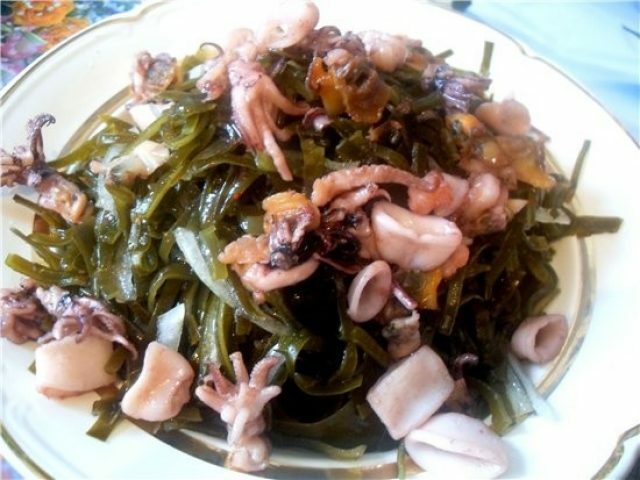
The uniqueness of sea kale is that no treatment reduces the amount of iodine contained in it
Ingredients:
- sea kale 200 g;
- seafood 50 g;
- onion 1 pc.;
- half a lemon;
- iodized salt to taste.
Preparation:
- Seafood( shrimp, octopus, squid) boil until cooked, clean. With a bow remove the husks and cut into half rings.
- Add sea prawns and onions to the sea cabbage, add salt, sprinkle with lemon juice. Shake the salad.
Apples baked with figs
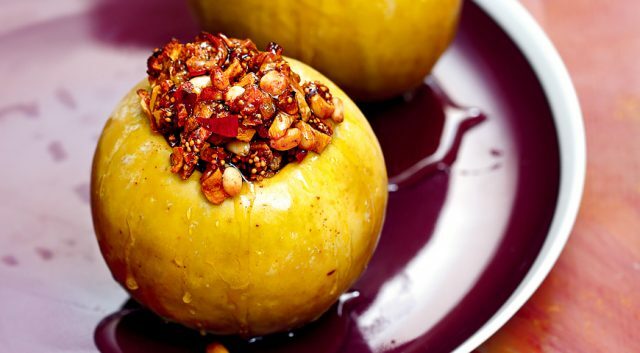
Baked apples are most suitable as a dietary dessert, and the figs are rich in useful trace elements
Ingredients:
- green apples 2 pcs.;
- dried figs 50 g;
- honey 4 tbsp.l.
Preparation:
- The fig is pre-poured with warm water for a quarter of an hour, after which it is crushed with a knife.
- Apples are washed, seeds are removed, pierce the skin with a fork in several places so that it does not burst during baking.
- In the middle of apples lay figs, put in the oven, wrapping each fruit with foil, and bake for 20 minutes.
- Baked apples should be served warm, previously removed from the foil and watered from above with honey.
Recipes for hyperthyroidism
The following recipes are good due to the use of zobogenic and protein-fortified products.
Rice with tofu( soy cheese)

Cheese tofu is made from soy milk, it is rich in protein and zabobnym product
Ingredients:
- cheese tofu 80 g;
- rice 100 g;
- broccoli 100 g;
- red pepper 1 pc.;
- soy sauce and salt to taste.
Preparation:
- Boil rice until done, salt.
- In the sauté pan, put the vegetables out a little, for 5 minutes.
- Put the vegetables in a deep plate, add diced tofu to them, fill with soy sauce, if necessary, salt, mix.
- To the rice laid out on the plate add a mixture of tofu and vegetables.
Fresh cabbage salad and raisins

Cabbage has a double benefit in thyrotoxicosis: it is an anti-inflammatory product and prevents constipation as a source of fiber
Ingredients:
- red cabbage 1 pc.;
- white cabbage 1 pc.;
- carrots 1 pc.;
- raisins 50 g;
- flaxseed oil 2 tbsp.l.;
- salt, sugar to taste.
Preparation:
- Take cabbage and carrots in a ratio of 2: 2: 1 and chop thin strips.
- Raisins pre-steamed in hot water for 20 minutes, add to the vegetables.
- Salad salt, season with oil, add a pinch of sugar and mix. Serve chilled.
The result of the diet
Regardless of the pathology, the main result of dieting is the normalization of the hormonal background. Along with this, the following results come:
- weight reduction to optimal values;

Correctly selected diet helps shchitovidke work without interruption, maintains the normal weight of the patient, strengthens the heart
- well-balanced work of the heart and blood vessels;
- improved mood;
- a decrease in nervousness and irritability;
- increased libido;
- restoration of genital function;
- improved appearance, attractiveness.
Doctors recommend dieting for any thyroid disorder. Feedback on the final results of the diet is always positive, if the diet plan you picked a doctor. Observing all the recommendations, it will be possible to restore thyroid functions without radical measures of cure, for example, surgical intervention.


